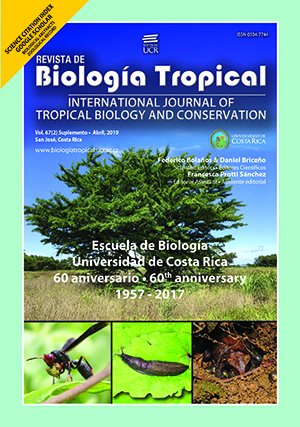Abstract
Woodpeckers nesting substrate abundance may be reduced by urban expansion, negatively affecting their reproduction. Long-term studies in the tropics are rare but valuable to estimate how urban development has affected ecological communities. We present a ten-year comparison on nesting substrate abundance and their use by Melanerpes rubricapillus and M. chrysauchen woodpeckers along an urban gradient in Golfito, Costa Rica; which include three habitats and three substrates (snags, palms, and posts). Conditions remained unchanged in non-urban areas. In semi-urban areas, snag, posts, and nests on them, have decreased. In urban areas, despite snags and posts remaining constant, their use also decreased. In semi-urban and urban areas, palms and palm nests increased. This long term comparison indicates that woodpeckers took advantage of the increased presence of ornamental palms in gardens.
References
Aitken, K. E. H., Wiebe, K. L., & Martin, K. (2002). Nest-site reuse patterns for a cavity-nesting bird community in interior British Columbia. Auk, 119, 391-402.
Baker, P. J., Bentley, A. J., Ansell, R. J., & Harris, S. (2005). Impact of predation by domestic cats Felis catus in an urban area. Mammal Review, 35, 302-312.
Barrantes, G., & Lobo, J. (2005). Protección de áreas silvestres en el bosque lluvioso del Pacífico húmedo de Costa Rica. In J. Lobo & F. Bolaños (Eds.), Historia Natural de Golfito, Costa Rica (pp. 241-252). Heredia, Costa Rica: Inbio.
Benítez, B., & Soto, F. (2010). El cultivo de la palma Areca (Dypsis lutescens, H. Wendel). Cultivos tropicales, 31, 62-69.
Blewett, C. M., & Marzluff, J. M. (2005). Effects of urban sprawl on snags and the abundance and productivity of cavity-nesting birds. Condor, 107, 678-693.
Boyle, W. A., Ganong, C. N., Clark, D. B., & Hast M. A. (2008). Density, distribution, and attributes of tree cavities in an old-growth tropical rain forest. Biotropica, 40, 241-245.
Cockle, K. L., Bodrati, A., Lammertink, M., & Martin, K. (2015). Cavity characteristics, but not habitat, influence nest survival of cavity-nesting birds along a gradient of human impact in the subtropical Atlantic Forest. Biological Conservation, 184, 193-200.
Cornelius, C., Cockle, K., Politi, N., Berkunsky, I., Sandoval, L., Ojeda. V., … & Martin, K. (2008). Cavity-nesting birds in neotropical forests: cavities as a potentially limiting resource. Ornitologia Neotropical, 19, 253-268.
DeLong, S. C., Fall, S. A., & Sutherland, G. D. (2004). Estimating the impacts of harvest distribution on road-building and snag abundance. Canadian Journal of Forest Research, 34, 323-331.
Dennis, J. V. (1969). The yellow-shafted flicker (Colaptes auratus) on Nantucket Island, Massachusetts. Bird-banding, 40, 290-308.
Fornasari, L., & Kimberg, P. (2011). UZGTL ESHSIA- Avifauna specialist study assessment for ESHSIA. In Golder Associates Afrita (PTY) Ltd. (Eds.), Impact Assessment report for the Gas To Liquids project of OLTIN YO’L GTL, near Karshi, The Republic of Uzbekistan (Appendix K, pp. 1-130). Uzbekistan: Uzbekistan GTL LLC and Golder Associates for the Asian Development Bank. .
Garrigues, R., & Dean, R. (2014). The birds of Costa Rica: a field guide (2nd ed.). New York: Cornell University Press.
Gibbs, J. P., Hunter, M. L., & Melvin, S. M. (1993). Snag availability and communities of cavity nesting birds in tropical versus temperate forests. Biotropica, 25, 236-241.
Gorman, G. (2014). Woodpeckers of the world: the complete guide. London: A&C Black.
Gutiérrez, M. V., & Jiménez, K. (2013). Crecimiento de nueve especies de palmas ornamentales cultivadas bajo un gradiente de sombra. Agronomía Costarricense, 31, 9-19.
Lobo, J., & Bolaños, F. (2005). Historia Natural de Golfito, Costa Rica. Heredia, Costa Rica: Inbio.
Magurran, A. E., Baillie, S. R., Buckland, S. T., Dick, J. M., Elston, D. A., Scott, E. M., … Watt, A. D. (2010). Long-term datasets in biodiversity research and monitoring: assessing change in ecological communities through time. Trends in Ecology and Evolution, 25, 574-582.
McClelland, B. R., & Frissell, S. S. (1975). Identifying forest snags useful for hole-nesting birds. Journal of Forestry, 73, 414-417.
Nilsson, S. G. (1984). The evolution of nest-site selection among hole-nesting birds: the importance of nest predation and competition. Ornis Scandinavica, 15, 167-175.
Peterson, A.W., & Grubb Jr, T. C. (1983). Artificial trees as a cavity substrate for woodpeckers. Journal of Wildlife Management, 47, 790-798.
Remsen Jr., J. V., & Robinson, S. K. (1990). A classification scheme for foraging behavior of birds in terrestrial habitats. Studies in Avian Biology, 13, 144-160.
Rico, D., & Sandoval, L. (2014). Non-random orientation in woodpecker cavity entrances in a tropical rain forest. Ornitologia Neotroprical, 25, 237-243.
Rosero-Bixby, L., Maldonado-Ulloa, T., & Bonilla-Carrión, R. (2002). Bosque y población en la Península de Osa, Costa Rica. Revista de Biología Tropical, 50, 585-598.
Sandoval, L. (2008). Implications of nest-site size selection on the nest building strategy in woodpeckers (Picidae: Aves). Métodos en Ecología & Sistemática, 3, 1-5.
Sandoval, L. (2009). Densidad de sitios para anidar y su uso por dos especies de pájaro carpintero (Melanerpes rubricapillus y M. chrysauchen) (Piciformes: Picidae) en un gradiente urbano de Costa Rica. Revista de Biología Tropical, 57, 351-355.
Sandoval, L., & Barrantes, G. (2006). Selección de árboles muertos por el Carpintero de Hoffmann (Melanerpes hoffmannii) para la construcción de nidos. Ornitología Neotropical, 17, 295-300.
Sandoval, L., & Barrantes, G. (2009). Relationship between species richness of excavator birds and cavity-adopters in seven tropical forests in Costa Rica. The Wilson Journal of Ornithology, 121, 75-81.
Short, L. L. (1979). Burdens of the picid hole-excavating habit. The Wilson Bulletin, 91, 16-28.
Stiles, F. G., & Skutch, A. F. (1989). A guide to the birds of Costa Rica. Ithaca, NY: Comstock.
Wilcove, D. S. (1985). Nest predation in forest tracts and the decline of migratory songbirds. Ecology, 66, 1211-1214.
Comments

This work is licensed under a Creative Commons Attribution 4.0 International License.
Copyright (c) 2019 Revista de Biología Tropical






